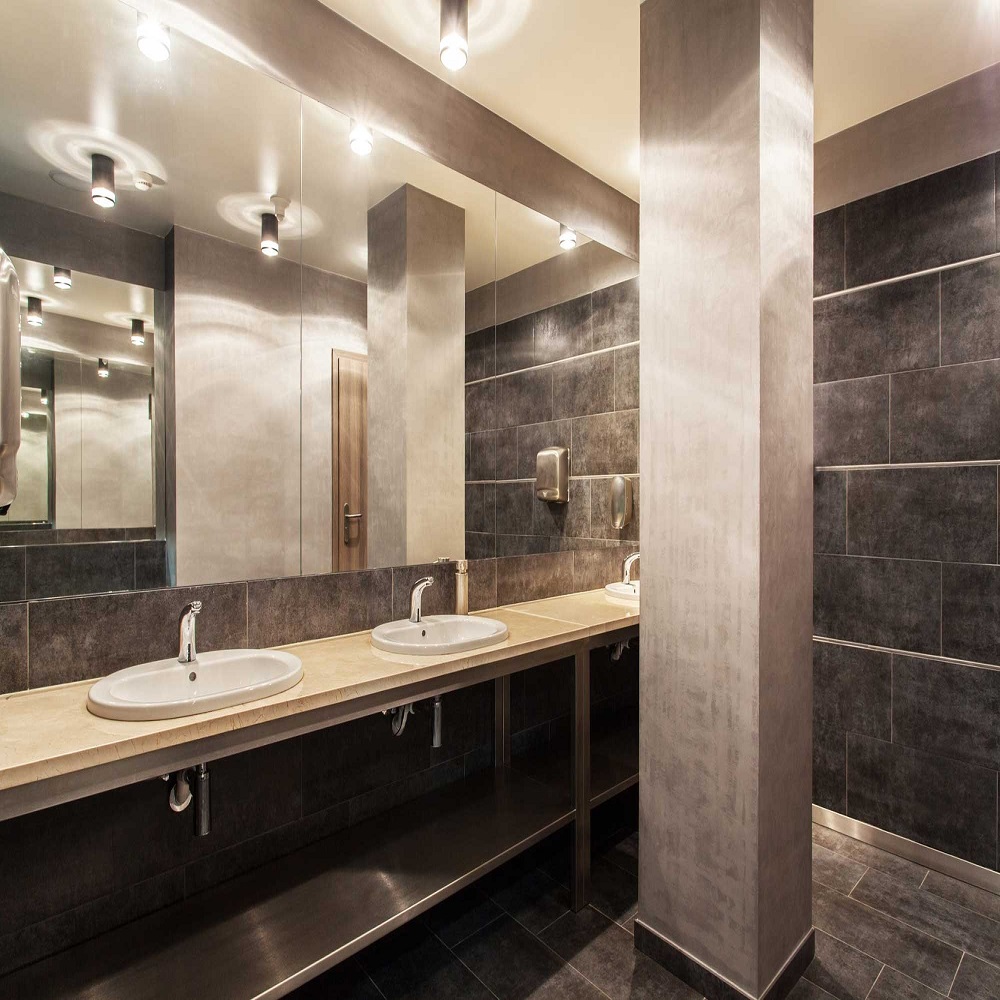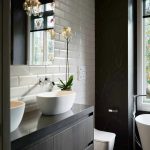Introduction to Commercial Bathroom Design Evolution
The design of commercial bathrooms has undergone significant changes over recent years. Initially, functionality was the main focus, with less emphasis on aesthetics or user experience. Simple designs and basic features were the norms in commercial settings. Today, however, we see a clear shift towards more innovative and user-friendly spaces. Architects and designers are now prioritizing both style and function, blending the two to create bathrooms that are not just practical but also pleasing to the eye.
This evolution is part of a broader trend in commercial architecture and interior design. Businesses understand that high-quality bathroom facilities can enhance the overall customer experience. As a result, there is a growing emphasis on creating spaces that reflect the brand’s identity and values. This can be seen in the choice of materials, the incorporation of technology, and attention to sustainability practices.
Another key aspect of the design evolution is the increased importance of inclusivity. Commercial bathrooms today are more likely to be designed with the needs of all users in mind, including those with disabilities. This has become a focal point as compliance with the Americans with Disabilities Act (ADA) is not just a legal requirement but also a reflection of corporate social responsibility.
Finally, health and hygiene have taken center stage, particularly in light of recent global events. Commercial bathroom designs are now incorporating features that promote cleanliness and minimize the spread of germs. Sensor-activated fixtures and touchless systems are just some examples of how design is adapting to meet these new health priorities.
Throughout this article, we will explore how these themes are defining the commercial bathroom design trends to watch in 2025.
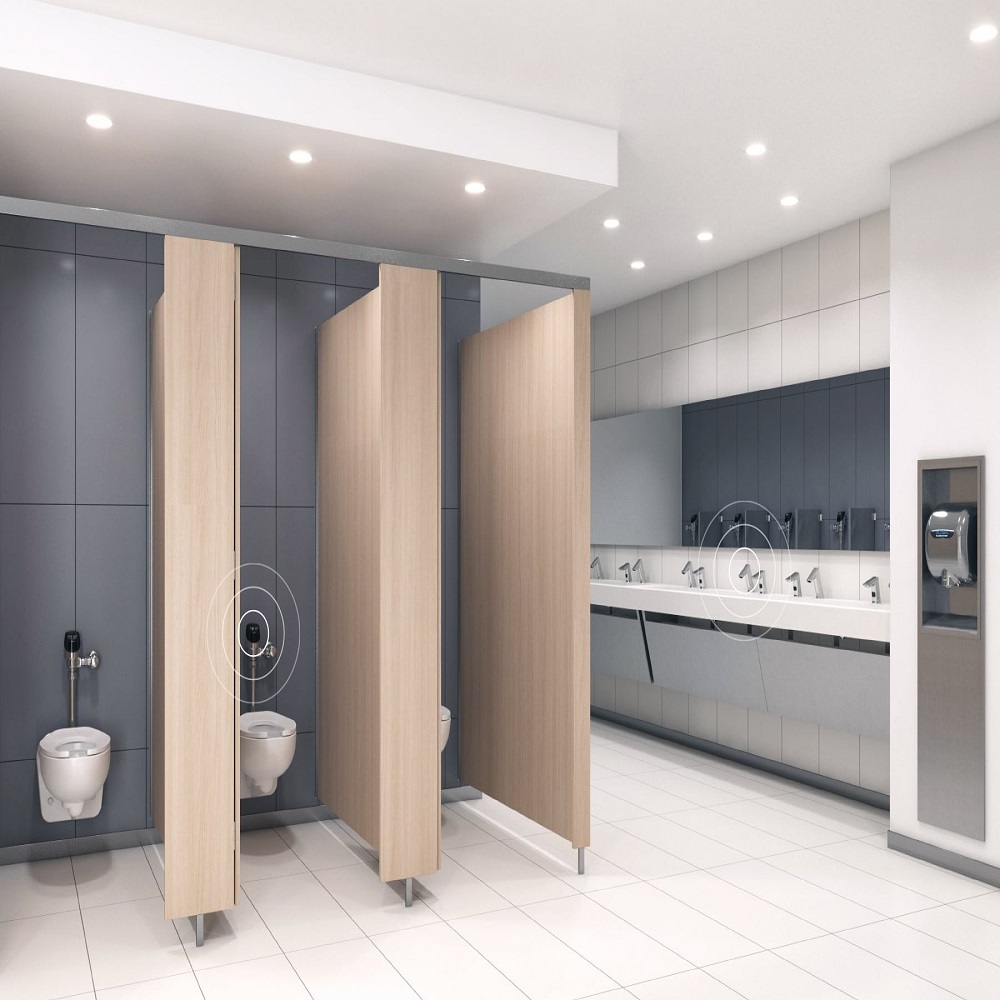
Eco-Friendly and Sustainable Design Choices
In 2025, sustainability is key in commercial bathroom design. Designers make eco-friendly choices to add value and appeal. Here are some trends:
- Water-Saving Fixtures: A must-have for any eco-conscious space. Low-flow toilets, faucets, and urinals are becoming standard. They reduce water usage drastically.
- Energy-Efficient Lighting: LED lights dominate for their low power consumption. They also offer a range of color temperatures, enhancing the bathroom’s ambiance while saving energy.
- Recycled Materials: Countertops and partitions made from recycled glass or plastics are on the rise. They help lower the carbon footprint of commercial bathrooms.
- Green Certifications: Bathrooms designed to meet LEED or WELL standards are now more common. They follow strict guidelines to ensure environmental friendliness.
- Natural Light: Incorporating windows and skylights reduces the need for electric lights. It also creates a pleasant atmosphere.
- Low-VOC Paints and Sealants: These reduce harmful emissions, improving indoor air quality.
All these choices reflect the push for sustainability in commercial bathroom design. They show a commitment to environmental conservation without compromising on style or function.
Smart Technology Integration in Commercial Bathrooms
Smart technology is transforming commercial bathrooms into spaces of convenience and advanced functionality. Here’s how 2025 showcases this trend:
- Touchless Operations: Sensor-based faucets, soap dispensers, and dryers offer a touch-free experience, reducing germ transmission.
- Automatic Cleaning Systems: Robotic cleaners and self-sanitizing surfaces ensure cleanliness with minimal human intervention.
- Smart Toilets: Toilets with automated features, such as seat sanitization and touchless flushing, enhance hygiene standards.
- Integrated Systems: Central systems control lighting, heating, and ventilation, optimizing energy use and comfort.
- Data Analytics: Usage data collected helps managers optimize maintenance and restocking schedules.
These technologies don’t just make the bathrooms more efficient; they also create a safer and more user-friendly environment. As smart tech continues to evolve, expect even more innovations to appear in the commercial bathroom landscape.
Accessibility and ADA Compliance Trends
Ensuring accessibility in commercial bathrooms is a major trend continuing into 2025. Here we see a focus on creating spaces that everyone, regardless of ability, can use safely and comfortably. Trends in ADA compliance for commercial bathroom design include:
- Wider Doorways: Allows easy access for wheelchairs and mobility aids.
- Handrails and Grab Bars: Installed by toilets and showers, they offer support and stability.
- Higher Toilets: Easier for individuals with limited mobility to use.
- Lower Sinks and Mirrors: Accommodate those in wheelchairs for a better experience.
- Spacious Stall Layouts: Provide room for caregivers and extra mobility equipment.
- Non-slip Flooring: Prevents accidents and enhances safety for all users.
- Signage with Braille: Helps visually impaired users navigate the bathroom with ease.
These elements not only meet ADA standards but also signify a business’s commitment to inclusivity. As commercial bathroom designs evolve, they must address the needs of all users, embodying both practicality and compassion in design.
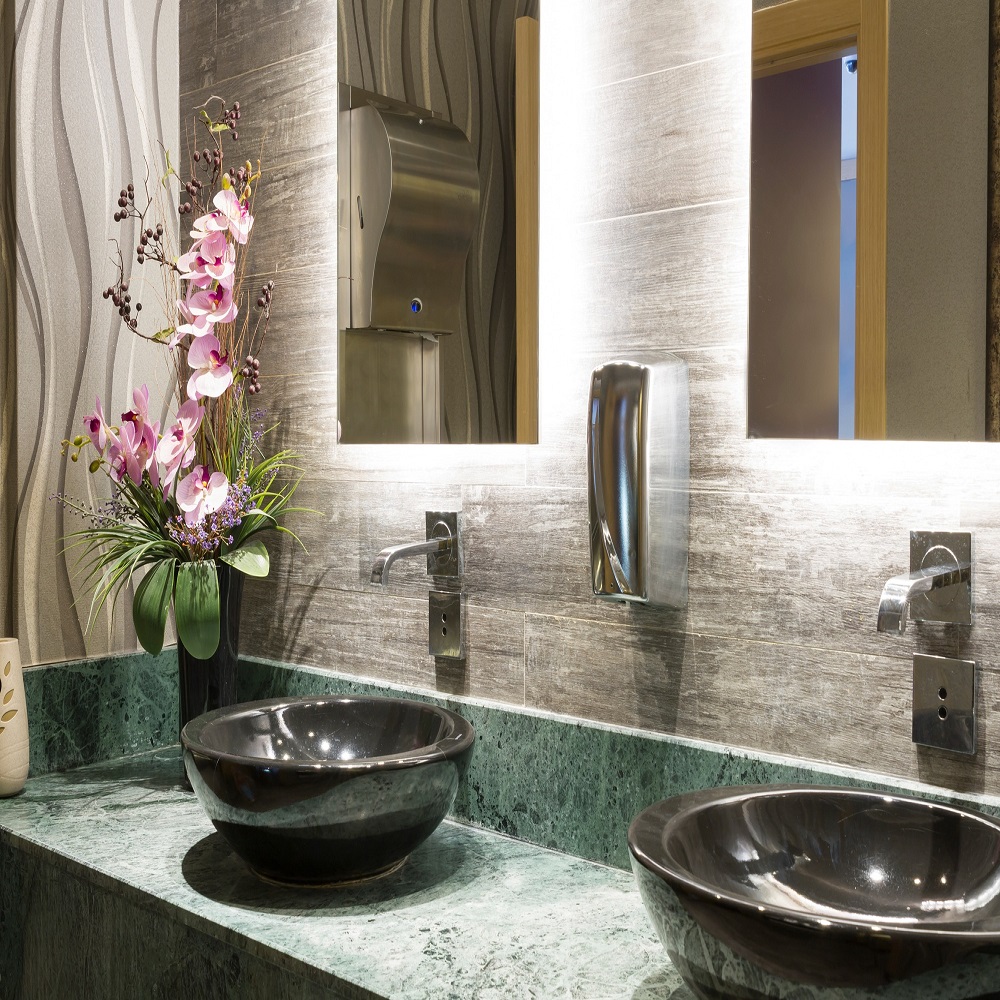
Innovative Materials and Surfaces for Durability and Aesthetics
In 2025, the materials and surfaces used in commercial bathroom design are as important as the fixtures and technology. Designers seek innovative solutions that offer both durability and appealing aesthetics. Here are a few trends defining this space:
- High-Tech Tiles: These are not your average ceramics. They come with properties such as self-cleaning, antibacterial, and air-purifying features, making maintenance easier while improving air quality.
- Solid Surface Materials: Materials like quartz and composite are gaining traction. They resist scratches and stains, plus come in a multitude of colors and patterns that can mimic natural stone.
- Antimicrobial Surfaces: Countertops and door handles that inhibit the growth of bacteria contribute to a healthier environment for users.
- Textured Finishes: Surfaces with textures not only offer a unique feel but also hide water spots and fingerprints, keeping the bathroom looking clean.
- Accent Walls: Durable, water-resistant wall panels in vibrant colors or interesting patterns can serve as focal points and add character to the space.
- Industrial Aesthetics: Exposed pipes and concrete surfaces are being polished and sealed to give a modern, industrial look without compromising on hygiene.
These materials and surfaces are key in crafting commercial bathrooms that are not just functional, but also visually striking. By using such innovative elements, designers are elevating the overall user experience and showcasing the brand’s commitment to quality and design.
Space Efficiency and Modular Designs
In the pursuit of optimizing space, 2025’s commercial bathrooms embrace space efficiency and modular designs. These concepts not only maximize usable space but also offer flexibility in layout and function. Here are some notable trends:
- Compact Fixtures: Toilets and sinks are designed to take up less room, providing more open space.
- Modular Partitions: These allow for quick reconfiguration of the bathroom layout to meet changing needs or preferences.
- Wall-Mounted Units: By attaching fixtures to walls, the floor space is kept clear, giving an airy feel to the bathroom.
- Multifunctional Components: Features that serve more than one purpose are popular; for instance, a sink with built-in storage.
- Sliding Doors: Instead of traditional doors, sliding options save space and modernize the design.
These space-saving solutions in commercial bathrooms not only cater to the need for flexibility but also help in maintaining a clutter-free and streamlined environment.
Color Schemes and Lighting in Modern Bathroom Design
When designing a commercial bathroom in 2025, the choice of color schemes and lighting plays a pivotal role. These elements are not only about aesthetics but also about creating an atmosphere that resonates with the brand and enhances the user experience. Let’s dive into the trends that shape these aspects in modern commercial bathrooms:
- Bold and Branded Colors: Businesses are choosing bold color palettes that align with their brand identity. Consistent use of brand colors produces a cohesive look and reinforces brand recognition.
- Neutral and Calming Hues: On the other end of the spectrum, neutral tones and calming hues are popular for creating a serene and inviting environment. These colors can make a bathroom space feel larger and more open.
- Dynamic Lighting Solutions: Modern bathrooms feature dynamic lighting systems that can adjust based on the time of day or mood desired. This ability to customize lighting adds to comfort and visual appeal.
- LED Accent Lighting: LED strips and accent lights are being used to highlight architectural features or artwork, adding depth and character to the commercial bathroom.
- Color Temperature Flexibility: Lighting with adjustable color temperatures allows for a warmer ambiance during evening hours and a brighter, energizing light during the day.
- Integrated Sensors: Lighting systems with integrated sensors can conserve energy by adjusting brightness according to the occupancy or natural light available in the bathroom.
Together, these color and lighting strategies create a commercial bathroom that is not just a facility, but a statement of design and technology. They contribute to an atmosphere that can leave a lasting impression on users and help a business to stand out.
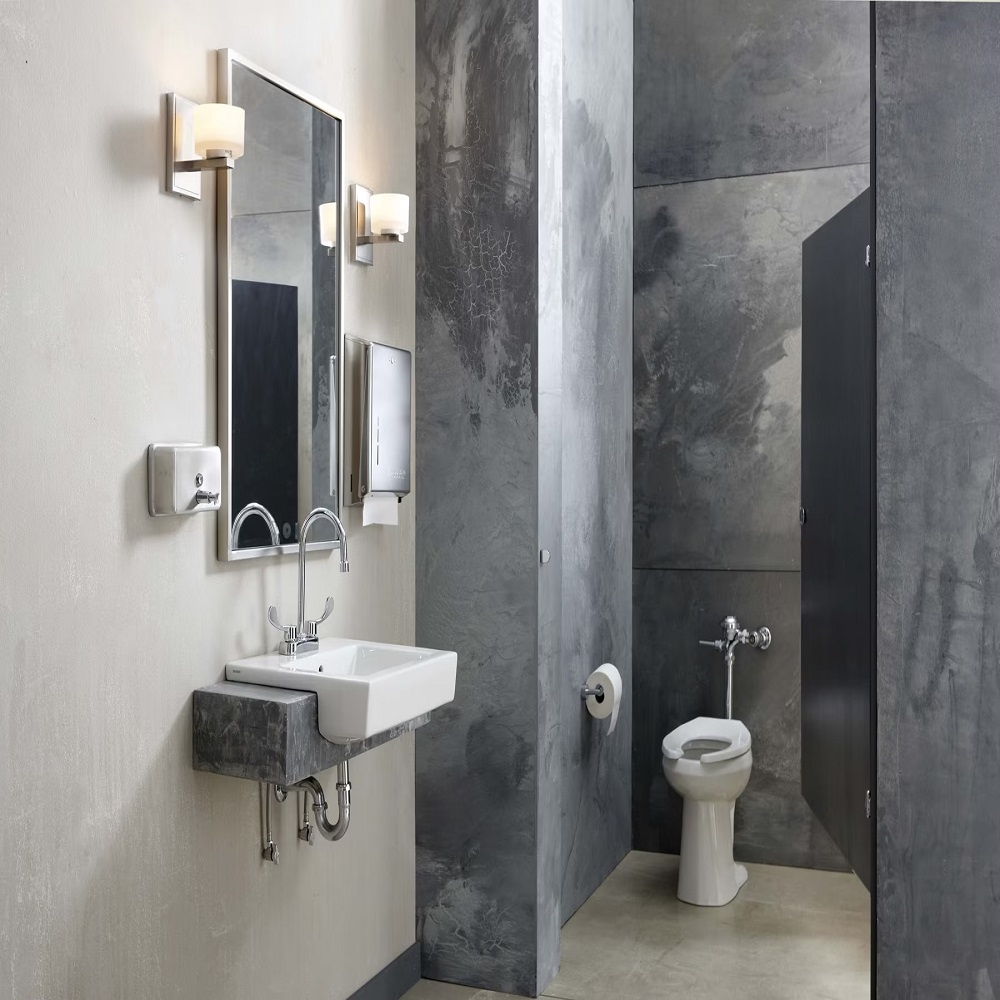
Health and Hygiene Focused Features
The year 2025 heralds a new era for health and hygiene in commercial bathroom design. As we prioritize cleanliness and germ control, the following features are in the spotlight:
- Touchless Technology: This tech is now a staple, from automatic faucets to soap dispensers and hand dryers. It reduces touchpoints and cross-contamination.
- Antimicrobial Finishes: Surfaces coated with antimicrobial agents help prevent the growth of bacteria and mold, making bathrooms more hygienic.
- Self-Cleaning Toilets: These advanced toilets cleanse themselves after each use, ensuring a consistently clean experience for every user.
- Air Quality Systems: New ventilation technologies work to remove airborne pathogens, thus improving the overall air quality in the bathroom.
- Sanitation Stations: Hand sanitizer dispensers are available at strategic points, encouraging good hand hygiene habits among users.
- Hygienic Waste Management: Sensor-activated waste bins minimize contact, while efficient disposal methods reduce the risk of contamination.
By incorporating these health and hygiene-focused features, commercial bathrooms are becoming fortresses against germs, offering peace of mind to all who use them.
Conclusion: The Future of Commercial Bathroom Design
As we gaze into the future of commercial bathroom design for 2025, it’s clear that innovative trends are setting the scene. These spaces are no longer just functional areas but are becoming statements of brand identity, commitment to sustainability, and technological advancement. The trends we’ve explored are about crafting experiences that are as visually pleasing as they are practical.
From the eco-friendly choices that reduce water usage and energy consumption to the integration of smart technology that bolsters convenience and hygiene, these designs are shaping a new standard. With every detail, including materials that offer longevity and aesthetic value, and layouts that maximize space, the future of commercial bathrooms strikes a balance between elegance and efficiency.
Color schemes and lighting techniques are carefully selected not just to complement the design but to enhance user comfort and mood. Complemented by health and hygiene features like touchless technology and self-cleaning toilets, they also address the pivotal concern for a cleaner, safer bathroom environment.
It’s apparent that in 2025, commercial bathrooms will continue to evolve. They will be places where design, technology, and function come together to offer more inclusive, sustainable, and engaging user experiences. For businesses, staying ahead of these trends is not merely a choice but a necessity in demonstrating forward-thinking and user consideration.
As we continue to innovate and push boundaries, the commercial bathroom will firmly establish itself not just as a necessity but as an integral part of the customer experience. It is an exciting time for designers, architects, and businesses as they contribute to this evolving landscape, one flush at a time.
